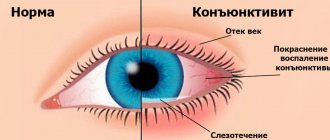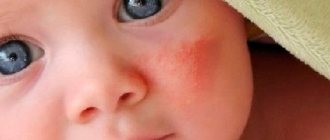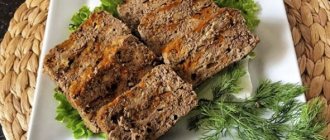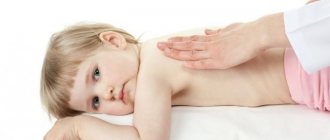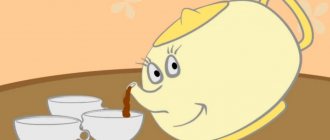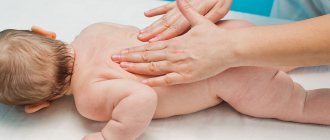Diathesis is accompanied by itching and redness.
The disease brings a lot of suffering to the baby. You can help your child if you become familiar with the treatment methods in detail. Diathesis is not an independent disease. This is a feature of the body, a reaction to certain influences.
They can be food components and hygiene products. If the disease is not treated, complications and serious illnesses may appear.
Redness is most often located on the cheeks, but can spread to the neck and chest.
Causes
The main causes of diathesis are:
- Food: eggs, chocolate, dairy products, citrus fruits.
- Long-term use of medications.
- Heredity.
- Artificial feeding. Some components of such a diet may contain allergens, which lead to diathesis.
- Infections in women during pregnancy.
- Eating junk food while pregnant.
- Flavors and dyes in personal care products. May cause irritation and lead to diathesis.
- Toxicosis during pregnancy.
- Pet hair. May have a negative effect on the child's body and lead to redness of the skin.
Varieties and characteristics
Experts distinguish four types of diathesis, each of which has certain characteristics:
- Exudative . Occurs at an early age and goes away by the age of three. Signs include redness of the cheeks on the face, swelling, itching. Formation of crusts on the scalp, diaper rash in the folds of the skin, abdominal pain, nasal congestion.
- Lymphatic-hypoplastic . Appears in 10% of cases. Formed at three years of age and disappears at school age. Signs: weak muscles, pale skin, lethargy, enlarged lymph nodes.
- Neuro-arthritic . Observed in 5% of cases. Occurs in infants and preschool children. Accompanied by redness of the skin, itching, constipation, intestinal colic, sleep disturbance, and excessive excitability.
- Hemorrhagic . It is very rare and difficult to tolerate. It is characterized by abdominal pain, stool upset, rashes on the body, and vomiting with blood.
Photo of diathesis on the cheeks of a child:
What to apply: recommended creams and products
Depending on the place of application, you need to choose the appropriate treatment. Experts have developed medications that are aimed at combating diathesis in a specific part of the body.
On the face and cheeks
Elidel cream is recommended for use for diathesis on the face and cheeks. It fights redness and helps relieve itching. The product can be used from three months of age. Apply the cream 2-3 times a day.
Guzhienko's paste is effective in the treatment of diathesis. It is used from the age of six months. The product is applied in a thin layer to the baby’s skin twice a day.
With regular use, the redness will disappear quite quickly: within one to two weeks.
It is allowed to use Advant cream from the age of four months. It eliminates diathesis in the shortest possible time and prevents it from reappearing. Apply the cream only once a day.
On the butt
Experts advise treating the baby with Desitin cream.
It combats red spots, itching and burning.
Diathesis on the butt disappears after a few days of using the medicine. You need to use it twice a day.
The drug Fenistil is recommended by experts. It contains effective components that quickly eliminate diathesis. The ointment is applied to the child’s bottom twice a day in a thin layer.
Triderm ointment can be used if the baby is over one year old. The product prevents diathesis from progressing and relieves itching and burning.
With this drug, the redness disappears within a few days. The medicine should be used once or twice a day.
On arms and legs
If redness appears on the baby's hands and feet, Diathesis of the feet ointment should be used. It is suitable for children over four months. Apply to skin 2-3 times a day.
It is recommended to cleanse the skin before use
The ointment does not cause pain, burning, acts very carefully
Diprosalik is recommended for severe diathesis, when redness has occupied a large area on the baby’s body. The product is recommended to be used only after reaching the age of one year.
The drug is applied in a thin layer to the damaged area twice a day. If the child’s diathesis progresses, it is allowed to increase the number of procedures to three per day.
Did you know that diathesis also occurs in adults? Symptoms may vary depending on the person's age.
What can be done to cure it quickly?
Diathesis on the cheeks of a child can be cured using various medications and folk remedies.
Medications
Doctors advise using the following ointments to treat diathesis:
- Tsindol.
- Dermovate.
- Fenistil.
- Advantan.
The products are applied to redness 2-3 times a day.
They are designed for children's delicate skin, so they do not cause harm. Ointments can be safely applied to the baby’s cheeks; they will relieve itching and redness.
To relieve itching, eliminate weakness, and red spots, it is recommended to take the following medications:
- Zodak.
- Zyrtec.
- Claritin.
- Tavegil.
It is enough for a child to take these medications twice a day, one tablet at a time.
For infants, half a tablet twice a day is enough. If the baby cannot swallow the tablet, it is recommended to crush it into a powder and mix with water . This makes it easier for the child to take the medicine. These medications must be taken for five days to avoid overdose and complications.
If the illness is accompanied by indigestion, you need to give the child activated charcoal in the amount of one tablet. It will cleanse the body and normalize digestion. This medication is necessary if diathesis is caused by a food product.
Folk remedies
To treat childhood diathesis on a child’s cheeks, nettle tea . To prepare it, mix a teaspoon of herbs and a glass of boiling water. The solution is infused for at least an hour, then filtered. The finished product should be consumed by the child instead of tea, 2-3 times a day. Nettle relieves redness, eliminates unpleasant itching of the skin, and improves the baby’s condition.
A remedy made from carrots is effective . Fresh carrots are grated. The resulting pulp is wrapped in gauze and applied to the redness for ten minutes, then the product is removed and the skin is wiped with a napkin. The procedure is carried out twice a day. You can use not only the carrots themselves, but also their leaves. They are crushed to a paste and applied as a compress for ten minutes. The medicine eliminates itching and redness.
You can treat your child with a remedy made from bay leaves . To do this, brew five bay leaves in a glass of boiling water. The mixture is infused for at least two hours. Apply the prepared medicine to damaged areas of the skin 2-3 times a day. The product can be used from a very early age.
How to treat children under one year old?
An excellent remedy for treating diathesis in babies under one year of age are Bepanten and La-Cri ointments , which effectively fight the disease without causing harm to the baby’s body. Lubricate the child's skin with these products morning and evening.
If crusts appear on the skin, there is no need to rush to remove them.
The child will be in great pain. To soften them, it is recommended to use Vaseline oil .
It is applied to the scabs 1-2 times a day. After a few days, the scabs will fall off on their own without pain. Aloe can be used as a compress . To do this, a small leaf of the plant is washed, cut lengthwise and applied with the sticky side to the damaged area for ten minutes, then the leaf is removed. The procedure is carried out in the morning and evening.
If the illness was caused by food, it is recommended to give the child the drug Smecta . To do this, half the contents of the sachet are diluted in a glass of warm boiled water. The medicine is given to the child 1/3 glass twice a day. A child should not take this drug for more than three days.
How to treat diathesis in a child?
24.12.2020
Diathesis is a fairly serious disease that must be treated under the strict supervision of a doctor . It happens that diathesis goes away as suddenly as it appeared, but very often it takes years to fight this problem. How quickly you can cope with the disease depends on the severity of the diathesis and compliance with the doctor’s . Correct and timely treatment can save a child from the disease forever. Therefore, it is very important to be attentive to the health of your children and observe moderation in consuming foods that can cause allergic reactions and know how to treat diathesis in a child.
This disease can appear in a child regardless of his age and lifestyle. Some children can eat anything, wear clothes made of any materials and use any care products and still not be afraid of allergic reactions . Others, at the slightest contact with this or that product or substance, immediately break out in a rash and suffer from itching. The causes of diathesis in children are completely different and the method of treatment will depend on the cause.
Diathesis can appear in an infant, a teenager, and even an adult. The disease itself usually goes through several stages, during which exacerbations occur. As a rule, diathesis in a child stops when he grows up, around the age of fifteen. But if by that time it was not possible to get rid of the diathesis , it may remain in an adult further, but in a chronic form, which is called neurodermatitis. The main signs of diathesis are constant itching of the affected area, the skin thickens and is constantly irritated. Diathesis can appear on almost any part of the human body - on the face , arms, groin or inner thighs.
There are also cases when diathesis is hereditary or appears due to the genetic predisposition of the baby’s parents to allergies . The most common causes of diathesis in children are the use of medications, contact with household chemicals, food, bacteria and certain types of fabrics. Diathesis be treated promptly, otherwise bronchial asthma or allergic runny nose diathesis and a runny nose appear at the same time requires immediate medical intervention and careful treatment.
diathesis is divided into dry and wet. swelling may appear on children's skin . In those places that are affected by diathesis , the skin is dry, peeling is very often noticeable, sometimes crusts and ulcers . Weeping diathesis got its name due to the fact that swelling and blisters appear on the child’s skin, which burst, revealing weeping areas on the skin. This disease can change its shape, and in combination with infections, pustular wounds may appear on the skin.
Despite the fact that diathesis manifests itself on the skin, it is not a skin disease, but only the body’s reaction to any irritants. Therefore, before treating diathesis in a child, you need to find out the cause of its occurrence and then apply comprehensive measures to cure it. As a rule, doctors prescribe many tests and examinations, as well as a diet , during which certain foods must be removed from the child’s diet. Over time, if the treatment is successful, all foods are gradually returned to the baby’s diet.
But not only regular use of medications is important in the treatment of diathesis . It is important to pay special attention to the hygiene of the child. If a child is prone to allergies , you need to take care of the cleanliness of the room in which he is located, so daily wet cleaning and ventilation are required.
Unfortunately, if your baby suffers from allergic reactions, you will have to remove pets or plants from the house. It is very important to bathe your child every day using hypoallergenic shampoos or soaps, and apply a softening and itching-relieving cream to the skin. All clothes that the child wears must be washed with non-allergenic powders , rinsed thoroughly and ironed on both sides with a hot iron. Such measures will prevent the appearance of fungi, and, therefore, the risk of diathesis will decrease.
Published in Allergology Premium Clinic
What does Dr. Komarovsky advise?
Recommendations for the treatment of diathesis on the cheeks of a child from Dr. Komarovsky:
- Before starting treatment, find out the cause of the diathesis. This will help stop the development of the disease.
- If the child suffers from itching, the skin is red, Elokom and Advantan ointments are used. They fight the unpleasant symptoms of the disease and eliminate them within a few days.
- To strengthen the child’s body and heal faster, it is recommended to give him calcium gluconate and vitamin D. This is necessary for a growing body.
- You should not overfeed your child, as this will worsen the allergy.
- You cannot comb or rub the redness. This will lead to complications.
- It is imperative to do wet cleaning in your child's room. The more often the better.
- It is better to choose clothes for your child made from natural fabrics, for example, 100% linen. It is safe and does not cause skin irritation.
- Allergenic foods (sweets, eggs, dairy products, citrus fruits) are excluded from the diet during treatment.
How to cure diathesis with folk remedies
Not only medications, but also folk remedies are effective in the fight against diathesis. It is recommended to give the child a medicinal decoction of vegetables and herbs. To do this, mix cabbage, dill and parsley in equal proportions.
The mixture is filled with a small amount of water.
It should be boiled for ten minutes and then strained.
The baby should be given the cooled solution in small portions twice a day. The course of treatment is five days.
You can prepare a medicinal ointment yourself. You need to mix four teaspoons of baby cream and two teaspoons of fir oil. The prepared product is applied to damaged areas three times a day.
A remedy made from sea buckthorn oil and brilliant green will help cope with diathesis. Add 30 drops of brilliant green to a bottle of oil (50 ml). The components must be mixed, the bottle is shaken.
After this, the medicine can be applied to problem areas three times a day.
Bay leaves help the child recover. You need to boil ten large leaves in a liter of water. Cooking time should not exceed five minutes.
Before removing the solution from the stove, it is recommended to add one tablespoon of rose hips to the mixture. The composition is infused overnight and filtered in the morning.
It should be taken half a glass twice a day.
Calendula tincture will help your baby's skin recover. To do this, combine 25 g of raw materials and one glass of boiling water. The solution needs to steep for one and a half to two hours. After this, the infusion is cooled and filtered.
During the day you need to make lotions from this product several times. It eliminates itching, burning, and helps eliminate redness. When the baby becomes healthy very soon, the child will stop feeling pain and being capricious.
Diathesis in children is a serious disease that causes pain and discomfort. If the diathesis is not treated, the redness will increase. It will lead to skin irritation and the baby’s whims.
Complex treatment will restore health and eliminate unpleasant symptoms and sensations. Before using medications, it is recommended to consult a doctor.
At home, you can very effectively treat your baby, eliminate swelling, red spots and burning. The parents’ task is to cure the baby and review his diet.
Perhaps the source of the problem is a certain product that is perceived by the child’s body as an allergen. A responsible approach to treatment will allow you to quickly get rid of diathesis.
What is not recommended to do?
During the treatment period you cannot:
- While taking a bath, you should not use scented hygiene products or with dyes, as they will increase irritation and there will be more red spots. It is better to use baby soap without any additives.
- During the treatment period, it is impossible to bathe the baby often and for a long time, since warm water leads to burning of the skin, the child becomes very painful, and this can cause complications.
- Combing or rubbing stains is prohibited. This leads to severe skin diseases.
- You cannot choose medications on your own or purchase medications to treat your child. Medicines are prescribed only by a doctor after examining the child and determining the cause of the disease.
- A breastfeeding woman is prohibited from eating sweets, citrus fruits, and eggs. You should follow a therapeutic diet so that allergens do not enter the child’s body along with milk.
Preventive measures
To prevent a child from developing diathesis, it is recommended to take preventive measures:
- Food should be healthy. The diet should not contain fatty or fried foods or allergenic foods.
- If a woman is breastfeeding, she must adhere to a therapeutic diet.
- Hygiene products must be free of dyes and fragrances.
- Clothing fabrics should be natural, not synthetic.
- Taking vitamins.
- Walks in the open air.
- Physical education classes.
Diathesis can be cured in various ways. There are medications and folk remedies to treat this disease. If treatment is started on time, the child will recover quickly enough, and the recurrence of the disease can be prevented.

